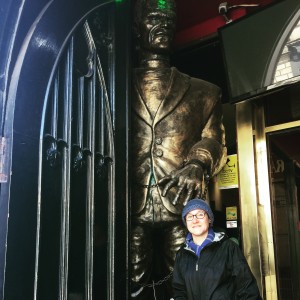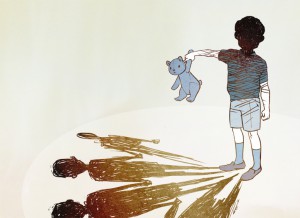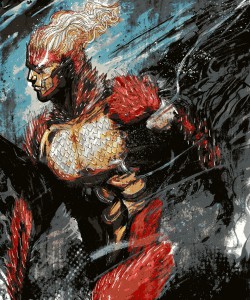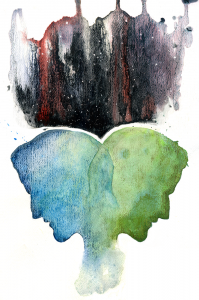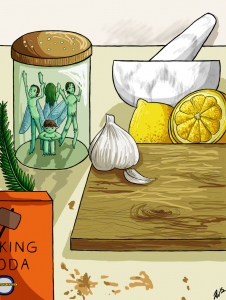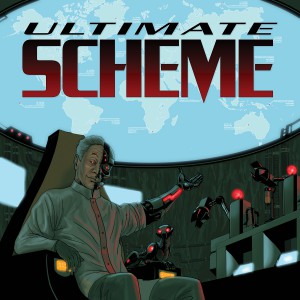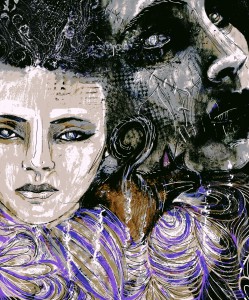An essay by Dr. David Jackson, as provided by Tom Howard
Art by Errow Collins
I woke up smelling ripe strawberries, then antiseptic and bleach. Small machines whirred and pumped around me, sounding familiar. I was afraid to open my eyes.
A series of beeps from a nearby machine betrayed my wakefulness. My blood pressure and breathing must have changed as I woke. Someone approached, the sound of the wearer’s fabric brushing against itself so loudly that I opened my eyes.
I tried to speak, but the intubation tube in my throat prevented me. I struggled to free myself from the restraints at my wrists and ankles. The bright lights, loud machines, and confining straps frightened me. My arms hurt, and I couldn’t feel my legs. Something stabbed the back of my head when I moved.
“Doctor!” shouted a nurse, moving to press my head back onto the pillow. At first, I assumed she called someone for help, but as she stared at me with concern and recognition, I realized she was addressing me.
“It’s going to be okay,” she promised, pressing a button above my bed. “Just try to relax, Dr. Jackson. You’re going to be fine.”
Somehow I knew she said that to all the patients, but I stopped struggling and tried to suppress my gag reflex. This tube had to come out. How did patients bear it?
Could I be Dr. Jackson? Looking down, I could see a slender man’s body dressed in a hospital gown under a thin blanket. I stared down at my unfamiliar arms, thin and pale. My legs, as much strangers to me as my arms, didn’t move when I ordered them to.
“David,” said a smiling man as he rushed into the room. He wore a white lab coat and a stethoscope around his neck. Balding and round, he looked at me with the same friendly familiarity as the nurse. He glanced at the machine registering my vitals and smiled again. “Don’t try to talk. Just lay back, and we’ll get that tube out.”
Without waiting for me to respond, he nodded to the nurse and reached for the plastic tube in my mouth. “You know the drill, David. Tilt your head back and relax your throat.”
I didn’t recall the drill but followed orders. The procedure didn’t go smoothly, but soon he’d removed the tube, and I coughed and retched. The nurse gave me a few sips of water and shut off some of the more urgent sounding machines.
“Dr. Logan? Roberto?” I asked, uncertain of where I’d gotten the man’s name. My voice cracked. A half dozen people–doctors, nurses, and administrators–had entered the room. “What’s going on?” I asked, trying not to panic.
Roberto put a beefy hand on my shoulder and squeezed.
“I’ll tell you all about it,” he promised, turning to the crowd. “Let’s let him get some rest, folks. He’ll be able to have visitors tomorrow.”
“How long have I been out?” I croaked, watching the people file out. Several of them waved at me.
“Six months,” replied Roberto. “I’m glad I haven’t forgotten how to remove a tube.” In a flash, I recalled he was a research scientist and not a regular MD. Why was he at my bedside instead of dissecting brains in his laboratory? As memories cascaded, I remembered he worked in our laboratory. He and I worked together on trying to understand the human brain. What the hell had happened to me?
“Do you know who you are?” he asked.
“Dr. David Lee Jackson,” I said. “You and I work together. What the hell happened, Roberto?” I lifted my head and an alarm went off. The nurse quickly silenced it and placed three cool fingers on my forehead to make me lie back. Out of the corner of my eye, I could see a bundle of wires running from the back of my head to several machines.
Roberto looked relieved at my answer. “Why don’t you tell me the last thing you remember?”
Silently, I tried to pull that memory out of the appropriate file cabinet in my mind. Not only couldn’t I find the folder, I couldn’t locate the damn cabinet. “It seems patchy.”
He nodded. “That’s to be expected. I’m amazed you can recall your name. Who’s the president?”
“Grover Cleveland, of course,” I said and chuckled when I saw his eyes widen. “Why is memory loss to be expected? What happened to me?”
Before he could respond, a young woman entered the room. She pushed Roberto aside and hugged me tightly.
“David, you’re awake!” she exclaimed. “They said not to get my hopes up, but I knew you’d come back to me.” I looked imploringly at Roberto over the top of her head when the hugs resumed, but he gave me a weak smile and shrugged.
Who the hell was she?

Suddenly I stood in an alley, a dark corridor that smelled like rotting garbage and urine. Someone faced me, a tall man, shouting. An explosion rang out, and the flash blinded me. I smelled hot blood and ran out of the alley, the man still screaming behind me. I heard the sound of squealing brakes.
To read the rest of this story, check out the Mad Scientist Journal: Winter 2016 collection.
Dr. David Jackson is a research scientist in Chicago, Illinois. He specializes in neurology, using technology to augment damaged brain tissue. He’s dedicated, friendly, and realizes he spends too much time in the lab. He’s afraid he’ll wake up one day and realize he should have stuck his head out the window occasionally.
Tom Howard is a fantasy and short story writer in Little Rock, Arkansas, who is currently working for a bank’s IT department in the Philippines. He doesn’t own any cats, but thanks his children for their inspiration and the Central Arkansas Speculative Fiction Writers’ Group for their perspiration.
Errow is a comic artist and illustrator focused on narrative work themed around worlds not quite like our own. She spends her time working with her partner on The Kinsey House webcomic and developing other comic projects when she’s not playing tag with her bear of a cat. More of her work can be found at errowcollins.wix.com/portfolio.

